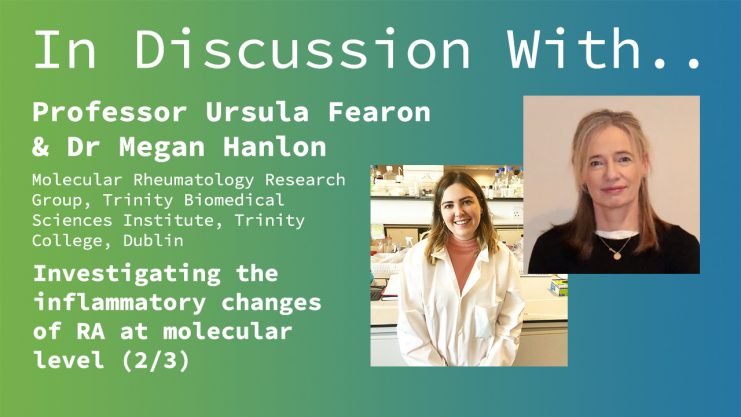Advertisment
Investigating the inflammatory changes of RA at molecular level

Interview and article by Christine Clark.
Professor Ursula Fearon and Dr Megan Hanlon describe a study that investigated the metabolic behaviour of circulating monocytes and how this relates to their immune-inflammatory activity in rheumatoid arthritis.
This study had three aims: first, to identify a signature of cellular dysfunction in monocytes in established rheumatoid arthritis; second, to find out whether the same signature was present in the ‘individuals at risk’ (IAR) (who had no clinical signs of RA) and third, to investigate the way in which the monocytes used energy in patients with rheumatoid arthritis, healthy controls and in IAR.
“We now know that immune cells – when they become activated in these diseases -they change the way they use energy. So, once they become activated they – like a kid in a sweet shop – they need to get energy really, really quickly and when they get that energy really, really quickly they become bad. That’s how the immune cells work with regard to metabolism – so they change the way they use energy to help them remain activated and be bad in this environment”, explains Professor Fearon.
Part of the thinking here was that finding out what changes in energy metabolism occur in monocytes in RA might offer potential therapeutic targets for reversing or preventing the development of the disease.
Methods and findings
Blood was collected from patients with rheumatoid arthritis, healthy controls and the IAR group. Peripheral blood mononuclear cells (PBMCs) were isolated; these were then magnetically labelled and sorted (using magnetic-activated cell sorting (MACS)) to yield a pure population of CD14-positive cells. “These monocytes would have been circulating the patients’ blood hours previously. So, once we isolated this pure population of monocytes we then ran a number of experiments looking at them ex- vivo, both unstimulated and under the influence of stimulation with LPS [lipopolysaccharide]”, explains Dr Hanlon.
There was a significant increase in the number of circulating monocytes in RA patients compared with healthy controls. Moreover, an inflammatory gene array showed that inflammatory markers were all hyper-responsive in the RA patients. Closer examination of three genes – those for TNFa, IL-6 and IL-1b – showed that they were significantly activated in RA-activated monocytes.
“Actually what was interesting with the genes that we found was that this inflammatory signature was very reminiscent of what an inflammatory M1 macrophage would produce in the joints. ……..So, we think that these cells are perhaps primed or poised to become inflammatory macrophages once they leave the blood and enter the joint”, says Dr Hanlon.
A greater inflammatory burden is associated with a greater demand for energy and examination of mitochondria – the powerhouses of the cell – in monocytes shows a mixture of regular- and irregular-shaped mitochondria in RA monocytes. More detailed investigation showed that the activated monocytes were relying predominantly on glycolysis rather than mitochondrial respiration for energy.
“Just looking at the metabolic phenotype profile you can see the switch from an aerobic, quiescent phenotype towards the hyper-energetic, hypermetabolic phenotype in RA-activated monocytes. We do see that both pathways are boosted however when we look at our ECAR:OCR ratio (extracellular acidification rate: oxygen consumption rate) we can see that it’s actually in favour of glycolysis. So, even though both pathways are up in these cells, [they] appear to depend more on glycolytic mechanisms than oxidative phosphorylation”, says Dr Hanlon.
When glycolysis was blocked using 2-deoxyglucose (2-DG), a glycolysis inhibitor, there was a complete abrogation of the inflammatory signature. This did not happen when other pathway was blocked.
STAT3 (Signal transducer and activator of transcription 3) is also known to play a key role in inflammation. In this study STAT3 was significantly enriched in RA monocytes compared to healthy controls and blockade of STAT3 resulted in resolution of inflammation.
“We get a big decrease in our inflammatory signature in the presence of this inhibitor. And, actually, again we get a decrease in the metabolic capacity of these cells so the hypermetabolic boost that these cells are under is returned to baseline in the presence of a STAT3 inhibitor”, says Dr Hanlon.
Read and watch the full series on our website or on YouTube.





